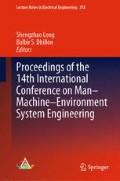Abstract
In order to examine the cognition behaviors of the physically disabled in the spatial environment such as subway system, we implemented the onsite eye-tracking experiment in the real subway environment. We hired 12 physically disabled people who sit on the wheelchairs and conducted certain experiment at National Library Station, Beijing Subway. By using SMI-HED eye tracker, we collected physiological data concerning disabled’s visual cognition performances such as fixation, saccades, and diameter of pupil and. Afterward, we implemented quantitative data analysis and established math model through correlation analysis between different variables. We found there remained a correlation between variance of saccade’s displacement with task time.
Access this chapter
Tax calculation will be finalised at checkout
Purchases are for personal use only
References
Cutrell E, Guan Z (2007) What are you looking for? an eye-tracking study of information usage in web search. In: Proceedings of the SIGCHI conference on human factors in computing systems
Al Maqbali H, Scholer F, Thom JA, Wu M (2013) Using eye tracking for evaluating web search interfaces. In: Proceedings of the 18th Australasian document computing symposium
Smith JD, Vertegaal R, Sohn C (2005) ViewPoint: lightweight calibration-free eye tracking for ubiquitous handsfree deixis
Giannopoulos I, Kiefer P, Raubal M (2012) GeoGazemarks: providing gaze history for the orientation on small display maps. In: Proceedings of the 14th ACM international conference on Multimodal interaction
Kiefer P, Straub F, Raubal M (2012) Towards location-aware mobile eye tracking. In: Symposium on eye tracking research and applications
Zhang Jun (2013) Data analysis of national disabled people’s basic database. Disabil Res 3:76–79
Wickens C, Hollands J (2000) Engineering psychology and human performance, 3rd edn. Merrill, Columbus
Author information
Authors and Affiliations
Corresponding author
Editor information
Editors and Affiliations
Rights and permissions
Copyright information
© 2015 Springer-Verlag Berlin Heidelberg
About this paper
Cite this paper
Fan, Y., Wang, W., Xin, Y., Lv, M., Wang, L. (2015). Eye-Tracking Analysis for the Disabled in the Spatial Environment. In: Long, S., Dhillon, B.S. (eds) Proceedings of the 14th International Conference on Man–Machine–Environment System Engineering. MMESE 2014. Lecture Notes in Electrical Engineering, vol 318. Springer, Berlin, Heidelberg. https://doi.org/10.1007/978-3-662-44067-4_9
Download citation
DOI: https://doi.org/10.1007/978-3-662-44067-4_9
Publisher Name: Springer, Berlin, Heidelberg
Print ISBN: 978-3-662-44066-7
Online ISBN: 978-3-662-44067-4
eBook Packages: EngineeringEngineering (R0)

